Matt Cordell on Wolf and Bob … and More
 February 21st, 2017 by jules
February 21st, 2017 by jules
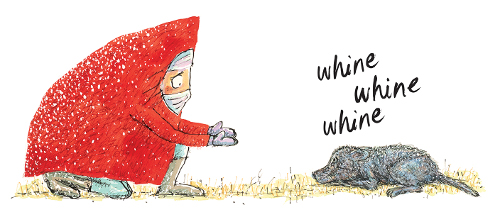
I’ve got a review over at BookPage of Matthew Cordell’s January 2017 picture book, Wolf in the Snow (Feiwel and Friends). That review is here, and I invited Matt for a chat that we started early in the year to talk about the book, how it’s changed over the years (you’ll read below that he started working on it in 2013), what else he’s up to (including Liz Garton Scanlon’s and Audrey Vernick’s Bob, Not Bob!), and more.
Enjoy!
Jules: Hi, Matt! Happy 2017.
Matt: Hey, Jules!
Jules: I was reading this just the other day, your late-2015 7-Imp visit, where you were schooling me (by request) in the ways of Radiohead — but also sharing images from Wolf in the Snow. It was a sneak peek of sorts, and now the book is out. And to all kinds of starred reviews. Congrats! When’d you start working on this one?
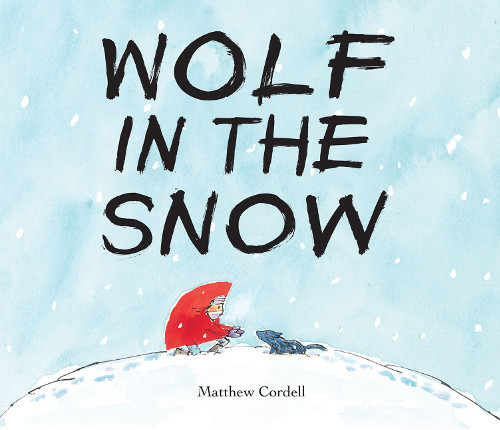
Matt: Wow. That was a while ago, huh? It’s good to be back at 7-Imp. Thank you for having me! Since that last post, we actually got to hang out in Knoxville over the summer. That was great fun! But, back to Wolf.
Yes, the reviews on this book have been staggering. I’ve come to expect that you never know what to expect with book releases, reviews, sales, etc. So I seriously had no idea any of that was coming. In fact, in the months leading up to it, I was fretting — all, “what if they HATE it?!” But when did I start working on it? I actually had to go back and look, because it was a long time ago. It was not easy bringing this book to life. My general formula for writing picture books is to either mine my own childhood experiences for ideas or to tease out something that my own kids have inspired me to write. Wolf was neither of those. It all started with this one image I drew back in the spring of 2013:
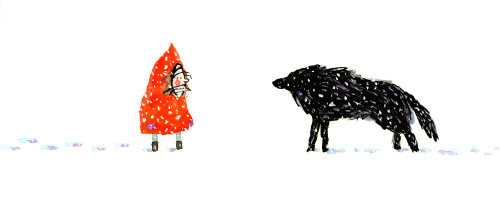
I had zero for story idea. I just had an image that led to a small series of images. In some of my previous books, I had fun playing with vast amounts of white space. The bit of idea I had was to make another one of those white-space books — but with a specific purpose. Obviously, snow would be a good idea. The next step for me was to think of characters that would scream out on a white, snowy background. For some reason, my mind’s eye pictured a black wolf and a girl in a bright red coat. What would they be doing? Heck if I knew. Here are a few of the other images that materialized as I played with this wannabe book without a story:


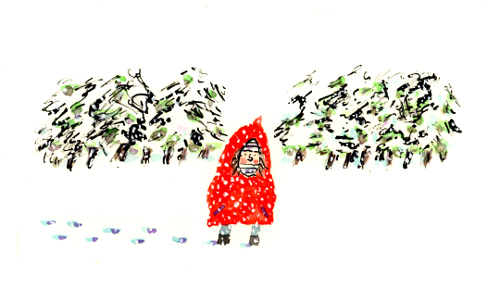
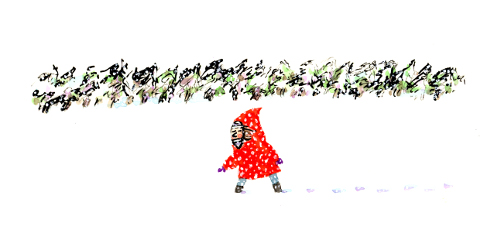
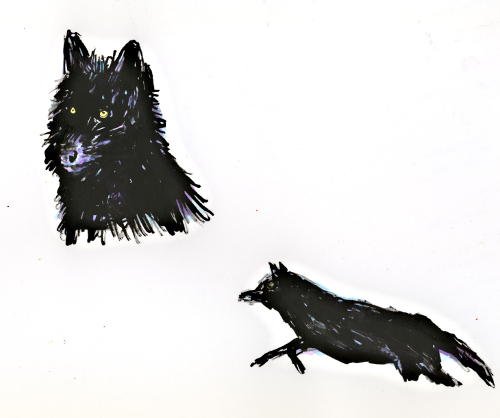
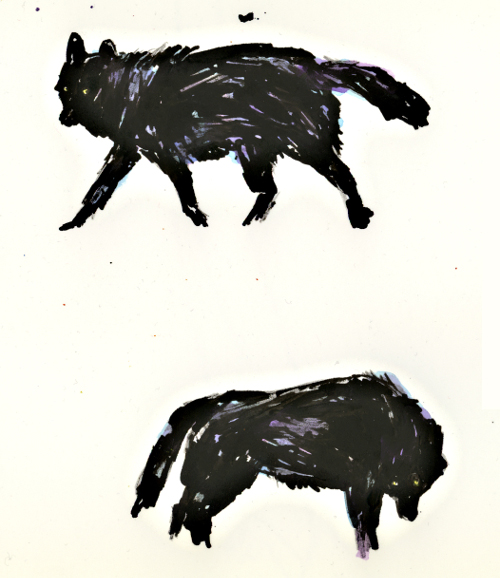

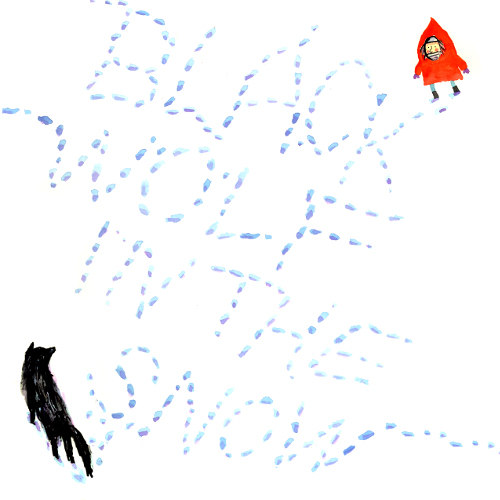
Jules: So, were you initially going to name it Black Wolf in the Snow (as seen in that last image)? And was it always (nearly) wordless, or did you attempt drafts with text?
Matt: Oh, gosh. There were so many drafts. I’ve been looking back on it here lately (for the purpose of presentations, promo, etc.), and I found nearly 15 different revisions over the course of, like, a couple of years or so — leading up to the point it was an approved, ready-for-finals sketch dummy. Yes, the earliest version was Black Wolf in the Snow. It was that way for much of the time. At one point, I changed it to simply Howl and then quickly changed it back and shortened it to Wolf in the Snow.
I fought for a long while, trying to figure out what the story was. From the beginning, I had the characters and setting in place but didn’t know what to do with them. So I started to do some research about wolves. The biggest thing I picked up on was how wolves are largely misrepresented in our culture and in history and literature (“Little Red Riding Hood,” “The Three Little Pigs,” etc.). Wolves are really demonized as being these vengeful, bloodthirsty beasts, out to sink their teeth into humans (or anything that moves) any chance they get. But it’s quite the opposite. Because of this misconception, over time wolves have been attacked and hunted and populations decimated — to the point where they are quite fearful of humans. This observation inspired me to turn these two characters, this girl and this wolf, into a story that is all too common and relevant in today’s world: How we often assume the worst of people we think we know well but truly know very little about. These two characters are clearly afraid of each other because of what they think they know about each other. But by the story’s end, they have somehow connected and helped each other and have been forever changed by the experience.
In the earliest drafts, it was only the child and the adult wolf. There was always going to be a blizzard and the girl is lost. The first drafts were, indeed, not wordless. In fact, I had this symmetry thing going on where the wolf and the child were thinking the same thing—fear, anger, cold, etc.—but in their own voices. So we could actually read/hear what the wolf was thinking.
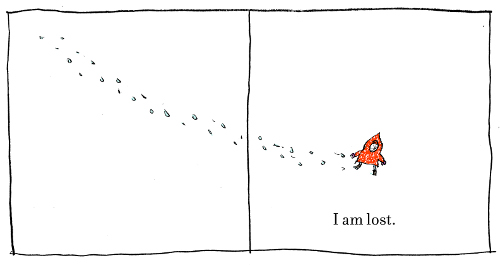
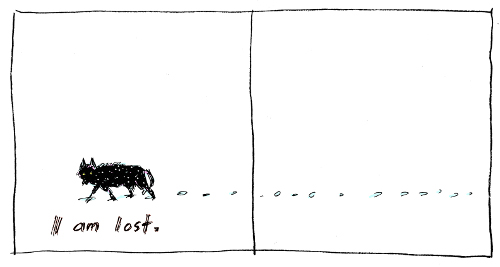
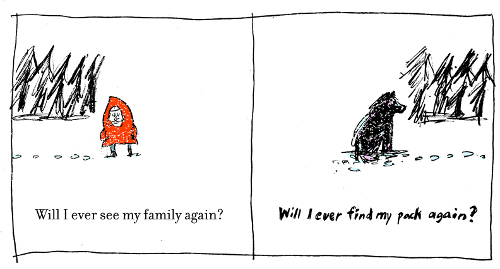
In that version, the girl and the wolf are lost. (It wasn’t clear why the wolf is lost, and that’s totally unrealistic, really.) And they encounter each other and get over their fear of each other to use their own different skills of deduction and keen smell, hearing, etc. to help each other get home. It was pretty bad.
Other versions included one where the girl is lost and encounters a wolf in a hunter’s trap (like a bear-trap type of thing) and frees the wolf. The wolf disappears and returns to help guide her back to her home. It was pretty bad.

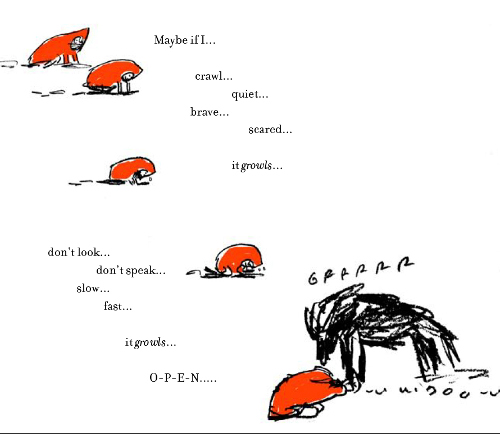

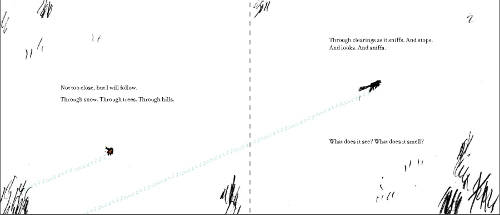
One thing led to another. The story became wordless, something I’ve never done. But for this book, it made perfect sense. These two are out in the middle of nowhere. There’s no talking. It’s freezing cold. The girl’s mouth is covered. All communication is body language and facial expressions. The inclusion of text started to seem extraneous and overly expository. And at some point, I added a wolf pup into the story, and things really started coming together. It became a child and a wolf pup who were lost at the same time and needed to find their families again. The struggle was more of a mirror. This all really helped and things started coming together.



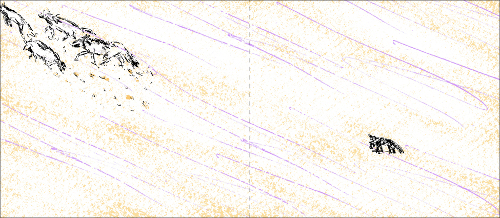


I got really hung up on trying to make this story as realistic as possible, trying to get the details of everything just right. What could really happen and what couldn’t? I read several books about wolves and humans. Watched documentaries. I looked for experts to talk to about wolves. I contacted the team that runs the Yellowstone Wolf Project, an initiative that reintroduced the grey wolf into Yellowstone Park from 1995-97 — after wolves had been completely wiped out in the park back in the 1930s. One of the team members, Kira Cassidy, was extremely helpful and supportive. Sidebar: The Yellowstone Wolf Project is fascinating and wonderful to learn about really — how and why it happened and the benefits to the ecosystem in the area after wolves came back. Here’s a short video that outlines some of it. It’s really, really cool:
And, still, I was really set on trying to make this book as realistic and believable as possible. Because of that, I wondered if I had to lose the idea of reciprocation. A human might help a wolf, but would a wolf really go beyond the safety and well-being of the pack to return the favor and help a human? As I got closer to what the book is, in finished form, I had a version where the girl and wolf pup are lost together. The girl helps the pup get back to its pack.
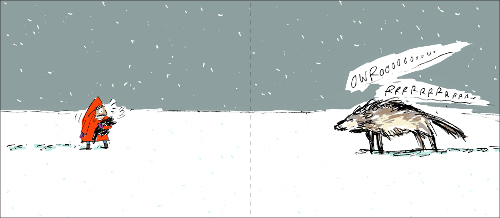
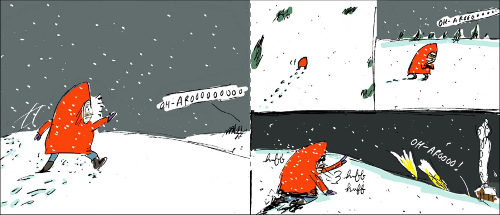
And then the girl eventually finds her own way home. No reciprocation in this version, but more realistic. I was confident enough to submit it to my editor at Feiwel and Friends like this, and they loved it and picked it up right away! But on one condition: They wanted an element of reciprocation at the end. When I saw that they wanted that, it was reason enough for me to give up this bit of “reality” and make a twist at the end that would be maybe more fictionalized but would speak to the idea that I’d really I wanted from the beginning — that people, no matter how different and how strained and negative relationships are in this world, still intrinsically want to help each other. I’m so glad that we did what we did with the ending.
Jules: Well, clearly it works, given the reception the book has received. Thanks for sharing the book’s history, its years-long metamorphosis. I wonder: How do you feel now about the experience of having created a wordless book, something that had been new to you? Do you think you’ll do another one in the future? I guess that’s hard to answer in that the story either calls for it or it doesn’t, right?
Matt: I’m pretty certain I’ll want to try another wordless book at some point down the road. Honestly, it wasn’t ever something I’d pined to do before I did Wolf. It just sort of became wordless by way of necessity. But now that I’ve done this, I’m looking at picture book-making with a slightly different set of eyes. I’ve got several books going right now that are all of the traditional, word…ful (?) variety. But somewhere in the mix, I’ve been tinkering with a new set of images that may or may not one day evolve into a wordless story. But maybe this is already too similar to my first wordless — you know, kid and animal. Or maybe that doesn’t matter. These were fun to draw, though.

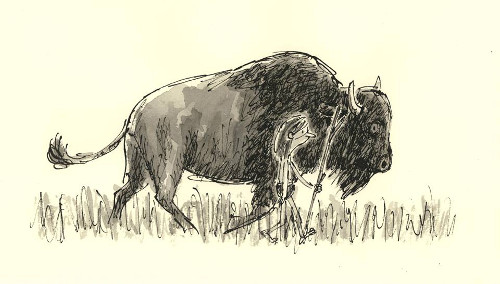
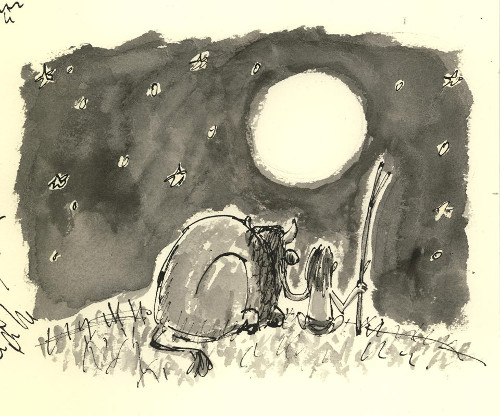


Jules: Oh, I love that last one. It brings to mind an image from hello! hello!
Tell me a about Bob, Not Bob!, written by Liz Garton Scanlon and Audrey Vernick. I like that one. Was it as fun to illustrate as it seems?
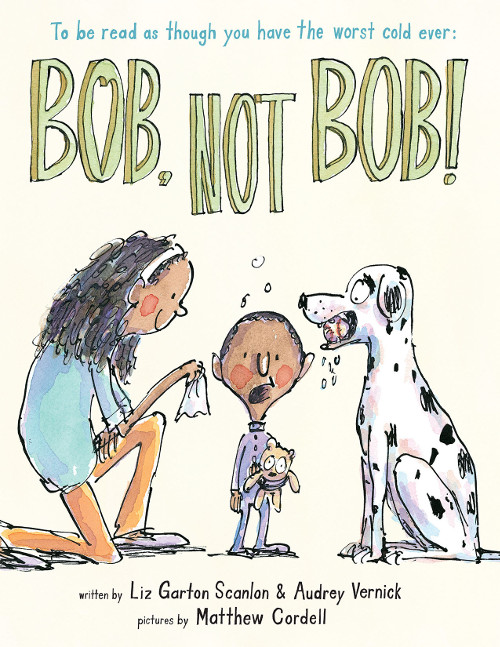
Matt: Ah … Bob! That one came my way via my editor at Disney-Hyperion, Kevin Lewis, who thought of me when he read the manuscript. He immediately had visions of Trouble Gum in his head when he read Bob, Not Bob! He was picturing lots of madcappery, big hand-lettering, and trapped-inside-the-house family fun. I loved his vision of it, and I loved the idea of throwing back to my ol’ Trouble Gum. And when I read the manuscript … well, man, I was sold. It’s so funny and so clever. In a nutshell, there’s this kid, Louie, who comes down with a horrible cold. He’s completely needy and helpless (as we all are with a horrible cold) and his nose is totally stopped up. Every time he calls for his Mom to come help him in bed, he means to yell “MOM!” — but his nose is so blocked that it comes out “BOB!” This, normally, would be fine, except he’s got a huge Great Dane dog named, um, Bob. So Bob keeps running and slobbering and jumping all over him. It’s really funny and really sweet. And also adequately gross and nuts at the same time.
I immediately went to sketching up this kid with a massive, bloated head. I had an idea that it could be super inflated at the worst of the cold, and as he improves it shrinks back down in size. In the end, I just had his head kinda big and bloat-y through and through — which I thought would still hit that mark and be good and consistent. I had some other nutty ideas, like he’d be walking around with invisible corks in his nose. As you do. But I got a little too gross-out with some of my crusty and mucus-y ideas, so they talked me down off of my booger-y ledge.
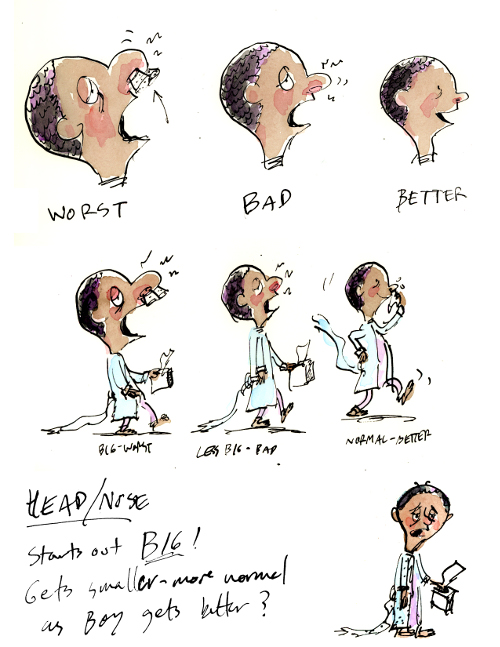
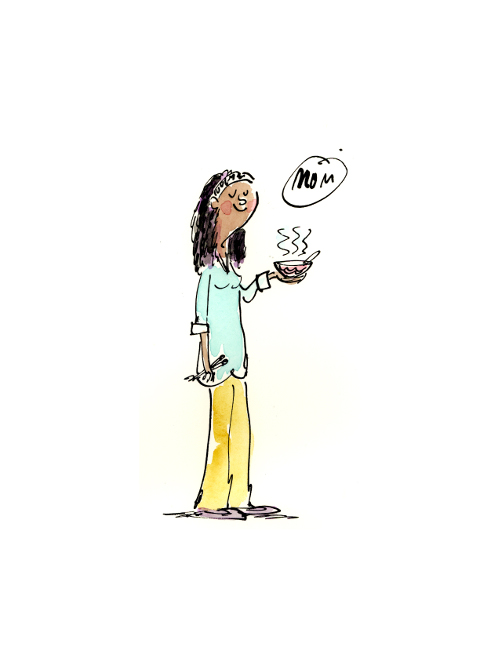
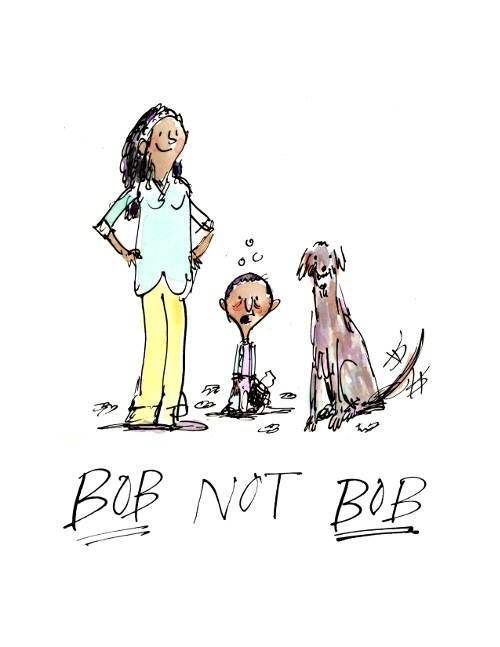
Oh! And initially, Bob was going to be a Scottish Deerhound. I always wanted Bob to be a big dog. And I saw one of those once, a Scottish Deerhound. They are big! And rather strange-looking. But that didn’t stick either. In the end, we settled on a big, black and white Great Dane. (That coloration is called “Harlequin.” See what we can learn when we illustrate picture books?) Without the cropped ears. Because I just don’t like the sound of cropping a dog’s ears. Yikes.
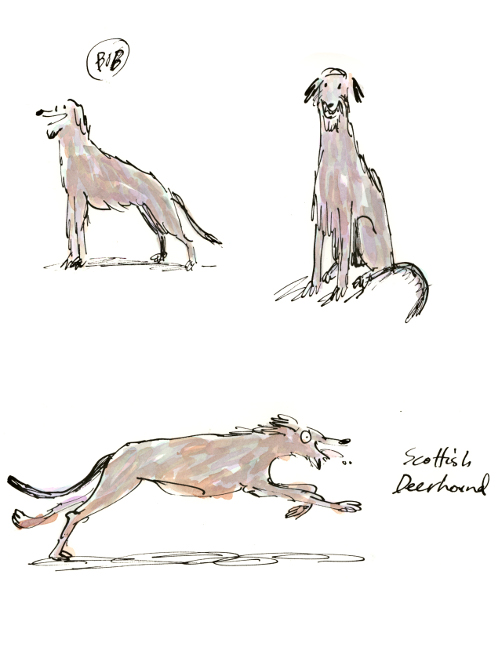
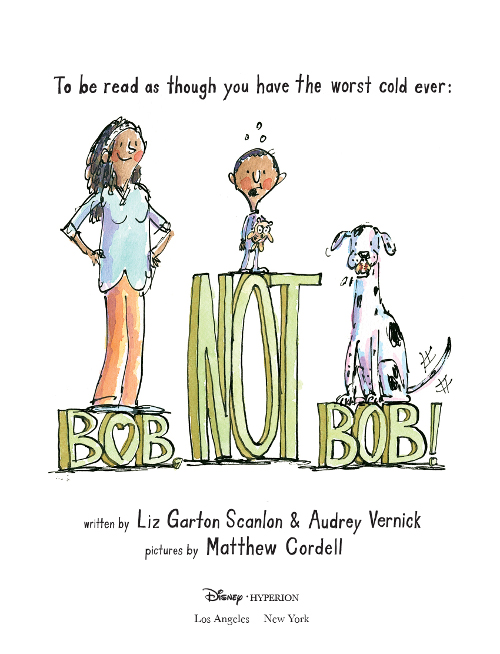
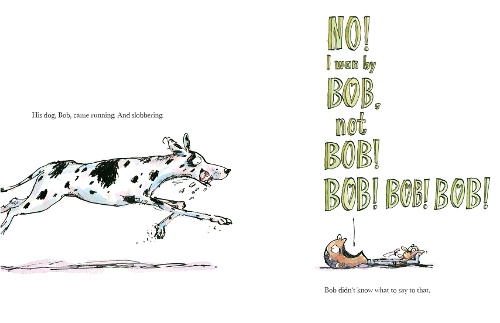
(Click to enlarge)

(Click to enlarge)
I also loved that it was written by not just one but two favorite picture book authors: Audrey Vernick (who I’d just collaborated with for First Grade Dropout) and Liz Garton Scanlon. That was a first for me! Next up: A picture book written by two authors and drawn by two illustrators?
Jules: I like how you mention Trouble Gum, because I thought of that too.
I think I already told you that my favorite moment in Bob, Not Bob! is a subtle one — the TV show “Everything Is Special!”
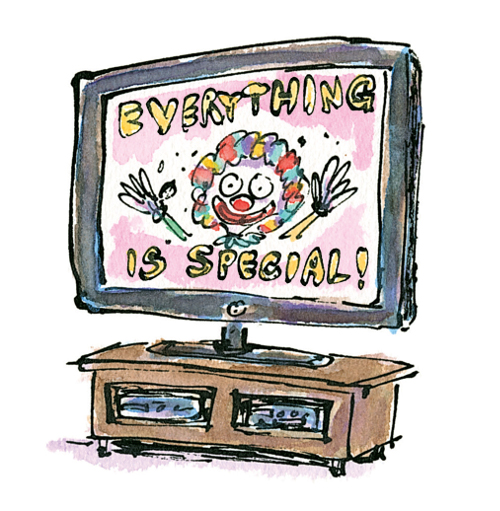
Matt: Ha ha. Yes, “Everything is Special!” That’s what’s on the TV in one particular moment in Bob.
I actually have a bit of a thing for making up weird TV shows in my picture books. Let’s see, there was …
“Baby Dude” in my book Another Brother:

… And from hello! hello!, “Captain Cosmos, Episode 119: Spacechimp Goes Bananas.” (119 was the number of the house where I grew up.)

Well, that’s it really. Not much of a “thing,” I guess. But I do get a kick out of it whenever the opportunity presents itself. Glad you did too!
Jules: Oh, yes. I remember Spacechimp!
I suppose we could go on … and on … and on … but that I should wrap things up. What’s next for you?
Matt: After Wolf and Bob, my next book out (on March 28) is Gone Camping with author Tamera Will Wissinger. It’s a sequel to our 2015 collaboration, Gone Fishing.
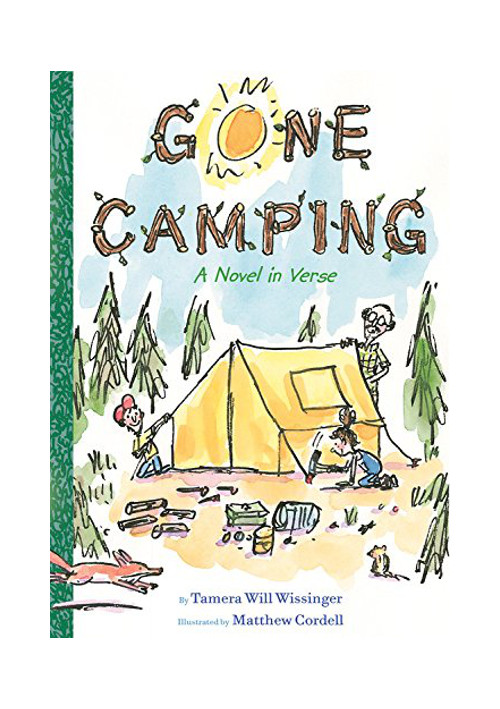
Then on July 4, I’ve got Second Grade Holdout, a sequel to First Grade Dropout, both with Audrey Vernick.

And on August 15, The Only Fish in the Sea …
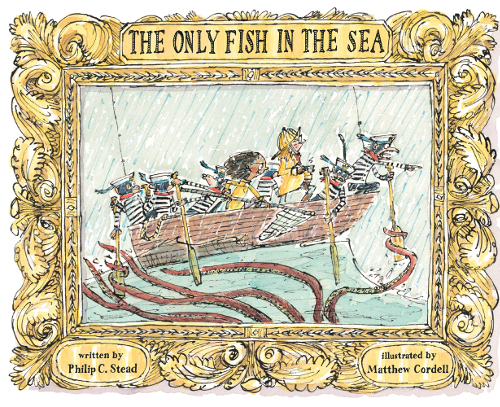
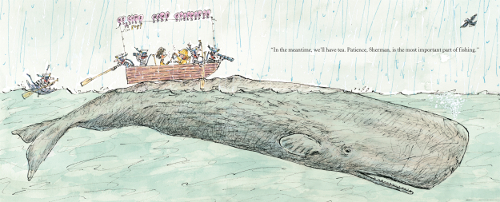
… a sequel to 2015’s Special Delivery with Phil Stead. Apparently, this is the year of the sequel for me! I’m cool with that. I loved being invited back to each and every one of these parties.
And, last but not least, my next author/illustrator picture book, Dream, will be out on May 2. This is a companion to my 2015 book, Wish. There will be one more in the series, Hope, that I’m working on now.
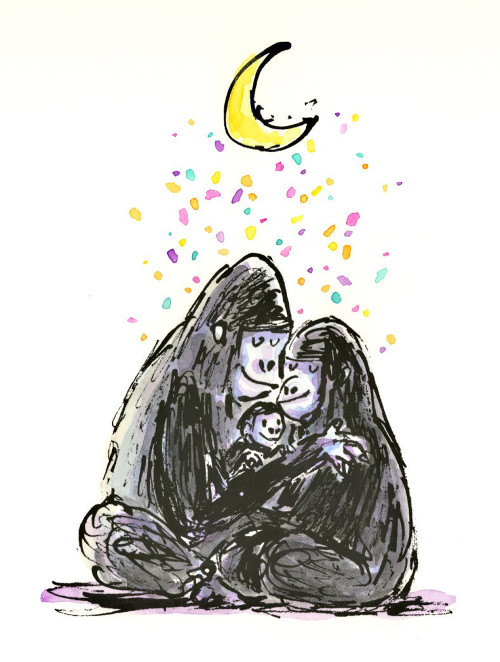
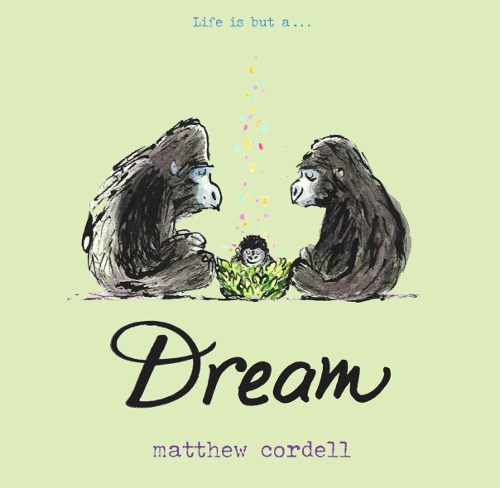
Jules: Looking forward to seeing these.
Thanks, as always, for visiting, Matt!

early on in helping me figure out Wolf in the Snow.”
— The Crusty Nibs (a Chicago-land illustrators group) with Kevin Henkes at his
2017 book event at Anderson’s Bookshop in Naperville, Illinois …
Pictured L to R: Chris Sheban, Tom Lichtenheld, Eric Rohmann, Matt,
Henkes (seated), Stacy Curtis, and Larry Day
(Click to enlarge)
All images are used by permission of Matthew Cordell.

I am so glad I finally had the time to read this post. It is excellent. I love knowing how this book came into being. Thank you Matthew and Jules. I will be adding a link to this to my blog post.
[…] announced, Matt’s Wolf in the Snow was named an Honor book in the Picture Book category. (Here is where Matt and I chatted about it back in February.) Congrats to him! I was really happy with […]